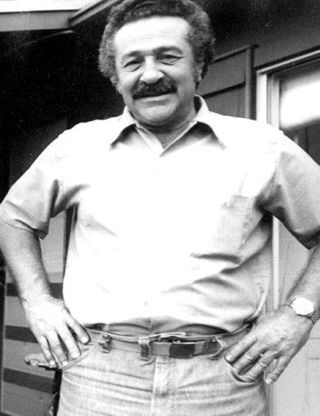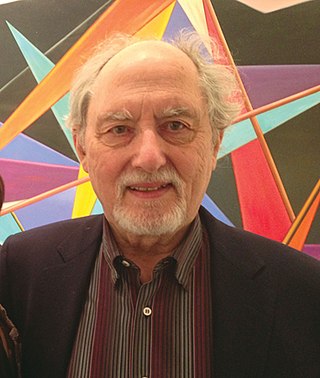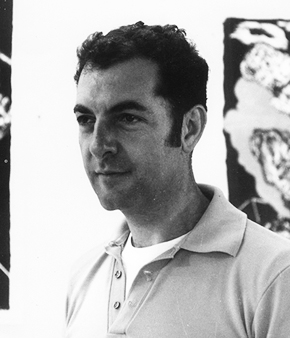Related Research Articles

Helen Frankenthaler was an American abstract expressionist painter. She was a major contributor to the history of postwar American painting. Having exhibited her work for over six decades, she spanned several generations of abstract painters while continuing to produce vital and ever-changing new work. Frankenthaler began exhibiting her large-scale abstract expressionist paintings in contemporary museums and galleries in the early 1950s. She was included in the 1964 Post-Painterly Abstraction exhibition curated by Clement Greenberg that introduced a newer generation of abstract painting that came to be known as color field. Born in Manhattan, she was influenced by Greenberg, Hans Hofmann, and Jackson Pollock's paintings. Her work has been the subject of several retrospective exhibitions, including a 1989 retrospective at the Museum of Modern Art in New York City, and been exhibited worldwide since the 1950s. In 2001, she was awarded the National Medal of Arts.

Leon Golub was an American painter. He was born in Chicago, Illinois, where he also studied, receiving his BA at the University of Chicago in 1942, and his BFA and MFA at the Art Institute of Chicago in 1949 and 1950, respectively.
Wolf Kahn was a German-born American painter.

Nathan Oliveira was an American painter, printmaker, and sculptor, born in Oakland, California to immigrant Portuguese parents. Since the late 1950s, Oliveira has been the subject of nearly one hundred solo exhibitions, in addition to having been included in hundreds of group exhibitions in important museums and galleries worldwide. He taught studio art for several decades in California, beginning in the early 1950s, when he taught at the California College of Arts and Crafts in Oakland. After serving as a Visiting Artist at several universities, he became a Professor of Studio Art at Stanford University.
Federico Solmi is a visual artist based in Brooklyn, New York.

Paul Feeley was an artist and director of the Art Department at Bennington College during the 1950s and early 1960s.

Irving Kriesberg was an American painter, sculptor, educator, author, and filmmaker, whose work combined elements of Abstract Expressionism with representational human, animal, and humanoid forms. Because Kriesberg blended formalist elements with figurative forms he is often considered to be a Figurative Expressionist.
James Welling is an American artist, photographer and educator living in New York City. He attended Carnegie-Mellon University where he studied drawing with Gandy Brodie and at the University of Pittsburgh where he took modern dance classes. Welling transferred to the California Institute of the Arts in Valencia, California in 1971 and received a B.F.A. and an M.F.A. in the School of Art. At Cal Arts, he studied with John Baldessari, Wolfgang Stoerchle and Jack Goldstein.

Edward Dugmore was an abstract expressionist painter with close ties to both the San Francisco and New York art worlds in the post-war era following World War II. Since 1950 he had more than two dozen solo exhibitions of his paintings in galleries across the United States. His paintings have been seen in hundreds of group exhibitions over the years.

Mitchell Siporin (1910–1976) was a Social Realist American painter.
Lester Johnson was an American artist and educator. Johnson was a member of the Second Generation of the New York School during the late 1950s. The subject of much of his work is the human figure. His style is considered by critics and art historians to be in the figurative expressionist mode.
Jack Roth (1927–2004), also known as "Rodney Jack Roth", was an American painter who developed a style as an Abstract Expressionist, and as a Color Field painter.
Robert Amft was a painter, sculptor, photographer, designer born in Chicago.
John Lees is an American contemporary expressionist artist who works primarily in painting.

Stephen Greene was an American artist known for his abstract paintings and in the 1940s his social realist figure paintings.
Robert Noel Blair was an American painter and sculptor from the Western New York-Buffalo area.
Sedrick Ervin Huckaby (1975) is an American artist known for his use of thick, impasto paint to create murals that evoke traditional quilts and his production of large portraits that represent his personal history through images of family members and neighbors.

William Conger is a Chicago-based, American painter and educator, known for a dynamic, subjective style of abstraction descended from Kandinsky, which consciously employs illogical, illusionistic space and light and ambiguous forms that evoke metaphorical associations. He is a member of the "Allusive Abstractionists," an informal group of Chicago painters self-named in 1981, whose paradoxical styles countered the reductive minimalism that dominated post-1960s art. In 1982, critic Mary Mathews Gedo hailed them as "prescient prophets of the new style of abstraction" that flowered in the 1980s. In his essay for Conger's fifty-year career retrospective, Donald Kuspit called Conger art-historically daring for forging a path of subjective abstraction after minimalism had allegedly purged painting of an inner life. Despite being abstract, his work has a strong connection to Chicago's urban, lakeside geography and displays idiosyncratic variations of tendencies identified with Chicago Imagist art. A hallmark of Conger's career has been his enduring capacity for improvisation and discovery within self-prescribed stylistic limits.

Seymour Rosofsky (1924–1981) was an American artist, who has been described as one of the key figures in twentieth-century Chicago art. He emerged in the late 1940s at the School of the Art Institute of Chicago, one of several G.I. Bill veterans, including Leon Golub, Cosmo Campoli and H. C. Westermann, who would join Don Baum, Dominick Di Meo, June Leaf, and Nancy Spero to form the influential movement later dubbed the "Monster Roster" by critic Franz Schulze, which was a precursor to the more well-known Chicago Imagists. Like others in the group, Rosofsky was drawn to the unsettling, macabre side of Surrealism, initially creating gestural, expressionist renderings of grotesque, existentially angst-ridden figures in isolated or uncomfortable situations, that gave way in the 1960s to more fantastical, observational paintings that examined power, politics and domestic relationships in an unflinching way.
Sidney Goodman was an American figurative painter and draftsman from Philadelphia, PA who explored the human form. Goodman received public notice in the early 1960s for his oil paintings, leading to his inclusion in the 1973 Whitney Biennial. In 1996, the Philadelphia Museum of Art presented a retrospective show of Goodman's paintings and drawings.
References
- ↑ http://www.library.northwestern.edu/archives/findingaids/george_cohen.pdf [ bare URL PDF ]
- ↑ "The Roster: George Cohen". Smart Museum of Art. June 10, 2016. Retrieved July 13, 2021.